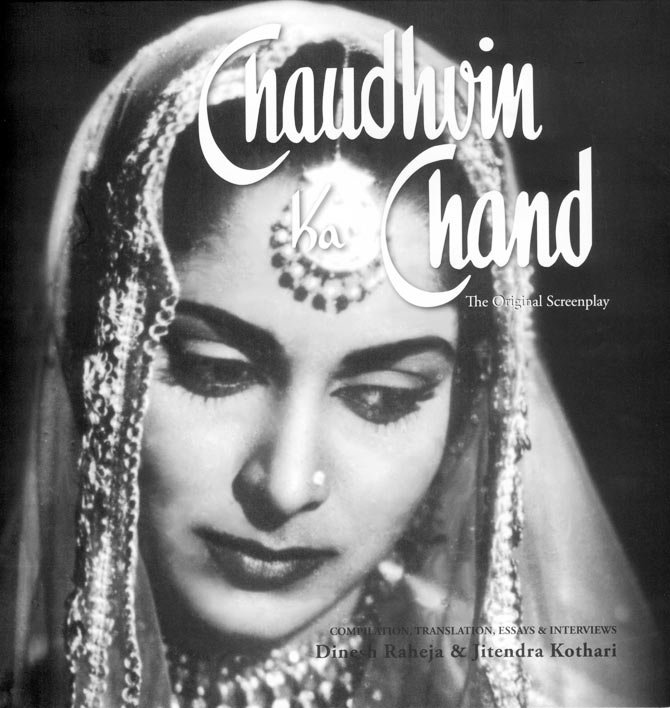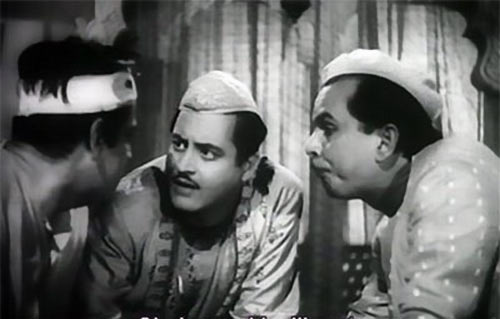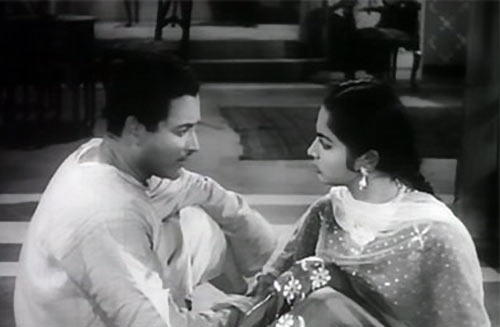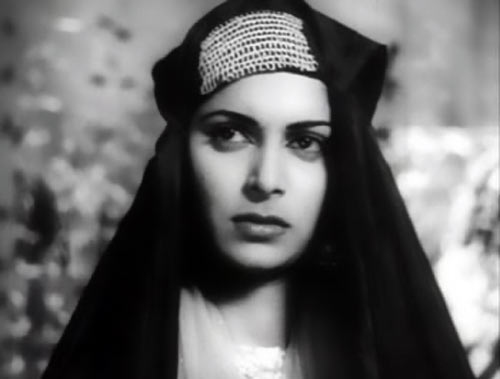
The ethereal Waheeda Rehman.
The lovelorn Guru Dutt.
When it comes to epic romances, Chaudhvin Ka Chand has to feature on the list.
The book, Chaudhvin Ka Chand: The Original Screenplay, archives the screenplay of this classic movie. It also offers interviews with the cast and crew, including its beautiful heroine, Wadeeda Rehman.
We present an excerpt:
In 1960, within eight short months of the box office debacle of his final directorial venture, Kaagaz Ke Phool, Guru Dutt released his next production, Chaudhvin Ka Chand, which was directed by a Bollywood veteran from the 1940s, M Sadiq.
The film’s story is rich with irony -– Pyaare Miyan (Rehman) is besotted with a beauteous, burqa-clad girl whom he has barely glimpsed, so he asks his friend Aslam (Guru Dutt) to marry the girl his mother has arranged for him.
But Pyaare eventually discovers that his friend’s wife (Waheeda Rehman) is, after all, the object of his affections and this leads to a frenzy of self-recrimination and sacrifice.
Compilation, Translation, Essays and Interviews: Dinesh Raheja and Jitendra Kothari. Excerpted from Chaudhvin Ka Chand: The Original Screenplay, Rs 595, published by Om Books International, with the publishers' permission. An initiative of Vinod Chopra Films Pvt Ltd.

Chaudhvin Ka Chand presented romantic intensity and fraternal sacrifice with heightened emotionality, but also dried out the moistness with adept humour.
The film was hugely successful at the box office. The inordinate success of this Guru Dutt production helped set into motion several staples of Hindi films.
Though ostensibly a romance, Chaudhvin Ka Chand’s thematic nucleus explored the deep emotional connection between the two friends -– Aslam and Pyaare Miyan.
Hitherto, there had been the occasional film that explored the nature of male friendship, including the successful Barsaat (1949) and Naya Daur (1957), but Chaudhvin Ka Chand ratcheted up the degree of the story’s commitment to the bonds of friendship.
Aslam places their friendship even higher than his wife, and Pyaare is so shamed by his inadvertent wooing of his friend’s spouse that he prefers to embrace death than face him.

Male friendship became an increasingly recurrent theme in the 1960s after Chaudhvin Ka Chand’s success -- films such as Hum Dono (1961), Sangam (1964), Dosti (1964), Ayee Milan Ki Bela (1964), Dil Ne Phir Yaad Kiya (1966), Padosan (1968), Sachaai (1969) and Aadmi Aur Insaan (1969) showcased the serendipitous or stormy alliances between male friends who are emotionally invested in each other's lives.
This development segued into the absolute plethora of buddy films -- such as Sholay, Yaarana and Dostana -- in the 1970s and 1980s.
By the turn of the millennium, Hindi film amigos were more self-conscious and less exhibitionistic about expressing their affection for each other but Dil Chahta Hai, (2001) Munnabhai MBBS (2003) and Zindagi Na Milegi Dobara (2011) indicate that the genre continues to thrive.
Chaudhvin Ka Chand’s success also gave an enormous fillip to the Hindi film genre known as the 'Muslim social'. This nomenclature simply specifies that the lead characters in the film are Muslim.
In Chaudhvin Ka Chand, director M Sadiq presented the film's milieu by lavishing detail of cultural traits in dress and language and endorsing the employment of ghazals (the title song), qawwalis (Sharma ke na yunhi pardanasheen) and high-flown Urdu in the dialogue.

The city of Lucknow and its famed Nawabi (royal) ethos formed the backdrop for Chaudhvin Ka Chand. Shakeel Badayuni's flowery lyrics extolled the city and its inhabitants:
Yeh Lucknow ki sarzameen, yeh rang-roop ka chaman, yeh husn-o-ishq ka chaman (This city of Lucknow. this garden of colour and beauty, this land of grace and gallantry)
Sadiq also adeptly showcased the characters' religio-cultural identity in the tehzeeb (etiquette) and customs of Pyaare Miyan's palatial house as well as the middle-class households of his friends Aslam and Shaida (Johnny Walker).
But, finally, the story concentrated on the characters' emotional lives, and the film's huge success testifies to the commonality of emotional impulses among all human beings everywhere.
Chaudhvin Ka Chand and Mughal-e-Azam were both released in 1960 and they certainly brought the appeal of the Muslim social back into audience consciousness.

Back in the 1930s and 1940s, several period films had been made on Mughal kings (Pukar, 1939; Shahenshah Akbar, Humayun, 1945; Shahjehan, 1946) and V Shantaram’s film on communal harmony (Padosi, 1941, with a Hindu and a Muslim as the main characters) had won considerable acclaim.
The Muslim social became widely popular after the success of Mehboob Khan’s Najma (1943), which was Ashok Kumar’s first release after scoring a blockbuster with Kismet (1943).
Subsequently, major filmmakers of the period such as A R Kardar (Dard, 1947), Sohrab Modi (Shama, 1946) and Mehboob Khan (Elaan, 1947) made family dramas with Muslim characters playing the central roles.
The 1950s, however, had Muslims protagonists in only the occasional film, such as the 1953 megahit Anarkali.
The true efflorescence of this genre began after Chaudhvin Ka Chand was released in June 1960 -– Mughal-e-Azam thronged theatres just two months later in August, 1960, and Barsaat Ki Raat (with Madhubala playing Shabnam and Bharat Bhushan playing Aman Hyderabadi) completed the hat-trick when it was released after another two months, in October 1960.